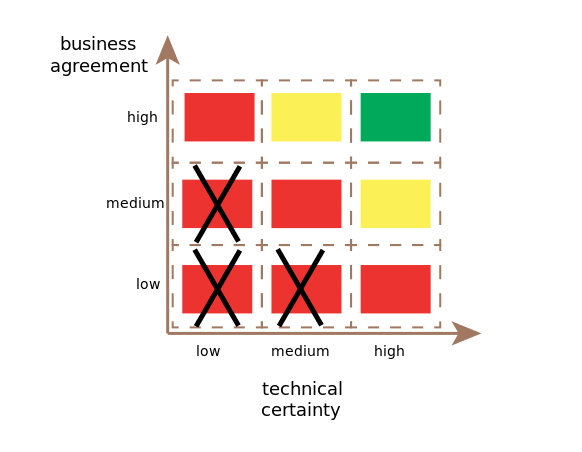Dealing with uncertainty
Ideas/techniques to help you be productive in the face of uncertainty
Basic idea
- Uncertainty about what to build and how to build it can hugely reduce your productivity and happiness as a developer
- Unclear goals
- Unclear acceptance criteria
- Unclear how to achieve things from the technological side
- It can be useful to make this uncertainty explicit
- There are some useful techniques for removing uncertainty
- In some cases, you might be able to start "working around the uncertainty"
- There are likely not only known unknowns but also unknown unknowns that only surface when you dive deep into the functionality or solution approach
- Unknowns are fact of life in software development
- It can be useful to make a conscious effort to tease them out early through mockups, prototypes, ... (see also Fail fast)
Analyzing uncertainty
Framework used at ThoughtWorks:

(image source )
Axes:
- Technical certainty: how well does the development team understand how to build the feature?
- Business agreement: how well does business agree on what goes into the feature and how the system should behave?
Different areas of the diagram:
- Red with cross: the task can't be done at the moment and you might also want to split/redefine it later on
- Red: the task needs clarification before it can be started
- Yellow: the task is not entirely clear, but it should be possible to start tackling it
- Green: it's clear what to do, the implementation should be relatively straightforward and predictable
Benefits of the framework:
- Makes uncertainty explicit
- Can help to start conversations needed to get rid of the uncertainty
- During conversations, focus on writing down what the questions and unknowns are that need to be resolved
Dealing with uncertain tasks
- Prioritize getting rid of the uncertainty
- In SCRUM, it can make sense to define a Spike for this (Spikes in Scrum )
- For highly uncertain tasks, it can make sense to postpone the implementation to the next sprint
- Assign someone to take the lead in removing the uncertainty
- Make sure to keep a clear list of what questions need to be answered
- If some parts are already clear, see if you can get started on implementing those
- You might be able to "work around the uncertainty"
- It might be possible to split off some unclear parts into their own tasks
- It might make sense to prioritize clarification of unclear tasks over implementation of clear tasks
- Tease out unknown unknowns as soon as possible
- Ensure that the team is not suddenly blocked by a backlog with only unclear tasks
- See also Fail fast
Removing technical uncertainty
Useful technique: time-boxing
- Pick a predefined amount of time (2 hours, 1 day, ...) to spend on researching and experimenting
- Can be done by one person or a small sub-team
- Research by itself is often not enough. You might need to build some kind of prototype to really get a feel for what works and what doesn't. See also Fail fast.
- When the time is up, get back to the team with the results
- Decide together with the team if further time-boxed sessions are needed/appropriate
Why it helps to time-box:
- Helps to prevent going down rabbit holes or getting stuck in analysis paralysis
- Forces regularly checking in with the team
- Can lead to useful ideas from the team for further time-boxed sessions
- Allows correcting course if needed based on feedback from the team
- The team can function as compass to help you focus on the essence
- See also Fail fast
- Allows re-evaluating whether the effort is actually worth it
Removing functional uncertainty
It often helps to do some kind of prototyping: mockups, wireframes, page flows, ... (see also Fail fast)